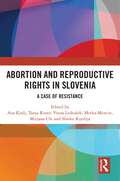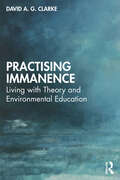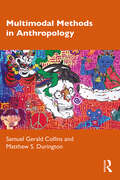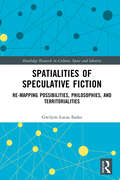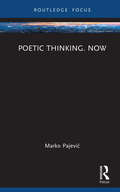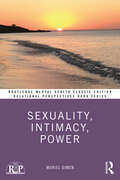- Table View
- List View
Abortion and Reproductive Rights in Slovenia: A Case of Resistance
by Ana Kralj Tanja Rener Vesna Leskošek Metka Mencin Mirjana Ule Slavko KurdijaAbortion and Reproductive Rights in Slovenia: A Case of Resistance provides a detailed and in-depth analysis of the situation of sexual and reproductive rights in Slovenia. This important intervention comes at a time when sexual and reproductive rights in Slovenia and around the world are assailed by populist and neoconservative discourses. The authors provide a detailed account of the history of the struggle for reproductive rights, particularly the struggles for access to safe abortion, insights based on interviews with fellow activists and an analysis of Slovenian public opinion on abortion in a temporal and comparative perspective. The scholar-activist authors put the issue of sexual and reproductive rights at the forefront of the social, political and scientific agenda in the name of collectivity and solidarity, reinforcing the potential apparent within civil society and social movements. This work will be of interest to researchers and activists with an interest in gender and reproductive rights in contemporary Europe.
Abortion and Reproductive Rights in Slovenia: A Case of Resistance
by Ana Kralj Tanja Rener Vesna Leskošek Metka Mencin Mirjana Ule Slavko KurdijaAbortion and Reproductive Rights in Slovenia: A Case of Resistance provides a detailed and in-depth analysis of the situation of sexual and reproductive rights in Slovenia. This important intervention comes at a time when sexual and reproductive rights in Slovenia and around the world are assailed by populist and neoconservative discourses. The authors provide a detailed account of the history of the struggle for reproductive rights, particularly the struggles for access to safe abortion, insights based on interviews with fellow activists and an analysis of Slovenian public opinion on abortion in a temporal and comparative perspective. The scholar-activist authors put the issue of sexual and reproductive rights at the forefront of the social, political and scientific agenda in the name of collectivity and solidarity, reinforcing the potential apparent within civil society and social movements. This work will be of interest to researchers and activists with an interest in gender and reproductive rights in contemporary Europe.
Practising Immanence: Living with Theory and Environmental Education
by David A. ClarkePractising Immanence: Living with Theory and Environmental Education makes creative contributions to both qualitative inquiry and environmental education by exploring how each of these ideas seep and fuse into one another, creating a space where methodology becomes pedagogy, and where each of these is already always environmental: indivisible with life. Clarke’s energising and innovative approach offers a challenge to conventional research practices and shows ways in which inquiry can be done differently. Drawing on new materialisms, affect theory and the practical philosophy of Gilles Deleuze and Felix Guattari, the book details the PhD journey of the author, merging stories and theory (and stories of theory) in the production of eight ‘haecceities’ – a philosophical concept which prioritises the thisness of a thing or event. This move allows a novel methodological approach whereby the haecceities act as sites of variation on the events of the book: the self as unstable and posthuman; the environment as everything (immanent) rather than as an overly romantic or a green version of nature; and the tensions that these moves create for ethical orientations in education, inquiry and life in the Anthropocene. Practising Immanence brings theory to life through a diffractively critical style and a unique approach to environmental pedagogic practice. This radical and vitalising book will be of interest to those inspired to explore environmental problems and inquiry with each other and to those drawn to creative-relational, narrative, embodied and post-qualitative approaches to research.
Practising Immanence: Living with Theory and Environmental Education
by David A. ClarkePractising Immanence: Living with Theory and Environmental Education makes creative contributions to both qualitative inquiry and environmental education by exploring how each of these ideas seep and fuse into one another, creating a space where methodology becomes pedagogy, and where each of these is already always environmental: indivisible with life. Clarke’s energising and innovative approach offers a challenge to conventional research practices and shows ways in which inquiry can be done differently. Drawing on new materialisms, affect theory and the practical philosophy of Gilles Deleuze and Felix Guattari, the book details the PhD journey of the author, merging stories and theory (and stories of theory) in the production of eight ‘haecceities’ – a philosophical concept which prioritises the thisness of a thing or event. This move allows a novel methodological approach whereby the haecceities act as sites of variation on the events of the book: the self as unstable and posthuman; the environment as everything (immanent) rather than as an overly romantic or a green version of nature; and the tensions that these moves create for ethical orientations in education, inquiry and life in the Anthropocene. Practising Immanence brings theory to life through a diffractively critical style and a unique approach to environmental pedagogic practice. This radical and vitalising book will be of interest to those inspired to explore environmental problems and inquiry with each other and to those drawn to creative-relational, narrative, embodied and post-qualitative approaches to research.
Crime, Science and Policing
by Gloria LaycockThis book offers an introduction to crime science; it is specifically for police and security professionals. Written by one of the founders of crime science and an expert in crime reduction, it considers the unique characteristics of the approach, its applicability to the control of crime, disorder and terrorism, and the importance of experimentation and the testing of new ideas to build a knowledge base for ethical policing. Core content includes: The basics of crime science in concept, theory and practice; Methods of research and assessment used by crime scientists; Crime science and policing, including its application to volume crimes, serious crimes and investigation; Legitimacy and public compliance; Policing, science, and future crimes. This book is essential reading for all students of professional policing, as well as those interested in crime and its control, reduction, and prevention.
Crime, Science and Policing
by Gloria LaycockThis book offers an introduction to crime science; it is specifically for police and security professionals. Written by one of the founders of crime science and an expert in crime reduction, it considers the unique characteristics of the approach, its applicability to the control of crime, disorder and terrorism, and the importance of experimentation and the testing of new ideas to build a knowledge base for ethical policing. Core content includes: The basics of crime science in concept, theory and practice; Methods of research and assessment used by crime scientists; Crime science and policing, including its application to volume crimes, serious crimes and investigation; Legitimacy and public compliance; Policing, science, and future crimes. This book is essential reading for all students of professional policing, as well as those interested in crime and its control, reduction, and prevention.
Globalization in World History (Themes in World History)
by Peter N. StearnsIn this fully revised fourth edition, this book treats globalization from several vantage points, showing how these help grasp the nature of globalization both in the past and today. The revisions include greater attention to the complications of racism (after 1500) and nationalism (after 1850); further analysis of reactions against globalization after World War I and in the 21st century; more discussion of student exchanges; and fuller treatment of developments since 2008, including the role of the Covid-19 pandemic in contemporary globalization. Four major chronological phases are explored: in the centuries after 1000 CE, after 1500, after 1850, and since the mid-20th century. Discussion of each phase includes relevant debates over the nature and extent of the innovations involved, particularly in terms of transportation/communications technologies and trade patterns. The phase approach also facilitates analysis of the range of interactions enmeshed in globalization, beyond trade and migration, including disease exchange, impacts on culture and consumer tastes, and for the modern periods policy coordination and international organizations. Finally, the book deals with different regional positions and reactions in each of the major phases. This includes not only imbalances of power and economic benefit but also regional styles in dealing with the range of global relationships. This volume is essential reading for undergraduate and postgraduate students of world history, economic history, and political economy.
Globalization in World History (Themes in World History)
by Peter N. StearnsIn this fully revised fourth edition, this book treats globalization from several vantage points, showing how these help grasp the nature of globalization both in the past and today. The revisions include greater attention to the complications of racism (after 1500) and nationalism (after 1850); further analysis of reactions against globalization after World War I and in the 21st century; more discussion of student exchanges; and fuller treatment of developments since 2008, including the role of the Covid-19 pandemic in contemporary globalization. Four major chronological phases are explored: in the centuries after 1000 CE, after 1500, after 1850, and since the mid-20th century. Discussion of each phase includes relevant debates over the nature and extent of the innovations involved, particularly in terms of transportation/communications technologies and trade patterns. The phase approach also facilitates analysis of the range of interactions enmeshed in globalization, beyond trade and migration, including disease exchange, impacts on culture and consumer tastes, and for the modern periods policy coordination and international organizations. Finally, the book deals with different regional positions and reactions in each of the major phases. This includes not only imbalances of power and economic benefit but also regional styles in dealing with the range of global relationships. This volume is essential reading for undergraduate and postgraduate students of world history, economic history, and political economy.
Multimodal Methods in Anthropology
by Samuel Gerald Collins Matthew S. DuringtonMultimodal Methods in Anthropology develops several goals simultaneously. First, it is an introduction to the ways that multimodality might work for students and practitioners of anthropology, using multiple examples from the authors’ research and from the field. Second, the book carefully examines the ethics of a multimodal project, including the ways in which multimodality challenges and reproduces “digital divides.” Finally, the book is a theoretical introduction that repositions the history of anthropology along axes of multimodality and reframes many of the essential questions in anthropology alongside collaboration and access. Each chapter introduces new methods and techniques, frames the ethical considerations, and contextualizes the method in the work of other anthropologists. Multimodal Methods in Anthropology takes both students and practitioners through historical and contemporary sites of multimodality and introduces the methodological and theoretical challenges of multimodal anthropology in a digital world. Like multimodality itself, readers will come away with new ideas and new perspectives on established ideas, together with the tools to make them part of their practice. It is an ideal text for a variety of methods-based courses in anthropology and qualitative research at both the undergraduate and the graduate level.
Multimodal Methods in Anthropology
by Samuel Gerald Collins Matthew S. DuringtonMultimodal Methods in Anthropology develops several goals simultaneously. First, it is an introduction to the ways that multimodality might work for students and practitioners of anthropology, using multiple examples from the authors’ research and from the field. Second, the book carefully examines the ethics of a multimodal project, including the ways in which multimodality challenges and reproduces “digital divides.” Finally, the book is a theoretical introduction that repositions the history of anthropology along axes of multimodality and reframes many of the essential questions in anthropology alongside collaboration and access. Each chapter introduces new methods and techniques, frames the ethical considerations, and contextualizes the method in the work of other anthropologists. Multimodal Methods in Anthropology takes both students and practitioners through historical and contemporary sites of multimodality and introduces the methodological and theoretical challenges of multimodal anthropology in a digital world. Like multimodality itself, readers will come away with new ideas and new perspectives on established ideas, together with the tools to make them part of their practice. It is an ideal text for a variety of methods-based courses in anthropology and qualitative research at both the undergraduate and the graduate level.
Colour Prejudice in Britain: A Study of West Indian Workers in Liverpool, 1941-1951 (Routledge Revivals)
by Anthony H. RichmondFirst published in 1954, Colour Prejudice in Britain is an account of the assimilation and adjustment of 345 West Indian workers who came to England between 1941 and 1943, many of whom have stayed to the present day. The study endeavours to trace the relationships between this group of West Indians and the English people with whom they came in contact over a period of approximately ten years. It is therefore a study in the two related fields of immigration and racial relations. This book will be of interest to students of sociology, history, and ethnic studies.
Colour Prejudice in Britain: A Study of West Indian Workers in Liverpool, 1941-1951 (Routledge Revivals)
by Anthony H. RichmondFirst published in 1954, Colour Prejudice in Britain is an account of the assimilation and adjustment of 345 West Indian workers who came to England between 1941 and 1943, many of whom have stayed to the present day. The study endeavours to trace the relationships between this group of West Indians and the English people with whom they came in contact over a period of approximately ten years. It is therefore a study in the two related fields of immigration and racial relations. This book will be of interest to students of sociology, history, and ethnic studies.
Of Reels, Romance and Retakes: Social Narratives of Cinema in Odisha
by Sanjoy PatnaikOf Reels, Romance and Retakes carries the reader on a fascinating journey into the genesis, evolution and reception of Odia cinema. Telling the story of its quiet emergence in 1936, the book goes on to chronicle its unexpected triumphs in the coming decades when cinema arose as an undisputed cultural form of both the middle class and the masses. The account the book gives of how Odia cinema, aesthetically intertwined with the indigenous folk and literary tradition, carried forward both the project of modernity and Odia cultural identity is particularly illuminating and instructive. At the same time it takes an introspective look at the crisis Odia cinema faces now, sandwiched as it is between two competing social trends - one following the route to Hindi as the chief language of entertainment and the other that is focused on regional cultural assertion as a key to commercial success. On the whole, it is a timely and much awaited book that seeks to construct the hitherto uncharted ‘social narratives’ of cinema in Odisha.
The Efficacy of Intimacy and Belief in Worldmaking Practices
This book explores ‘efficacious intimacy’ as an embodied concept of worldmaking, and a framework for studying belief practices in religious and political domains. The study of how beliefs make and manifest power through their sociality and materiality can reveal who, or what, is considered effective in a particular socio-cultural context. The chapters feature case studies drawn from diverse religious and political contexts in Asia, Africa, and the Americas, and explore practices ranging from ingesting sacred water to resisting injustice. In doing so, the authors analyze emotions and affects, and how they influence dynamics of proximity and distance. Taking an innovative approach to the topic of intimacy, the book offers a fascinating examination of how life-worlds are constructed by material practices. It will be of interest to scholars of anthropology, religion, and material culture.
Of Reels, Romance and Retakes: Social Narratives of Cinema in Odisha
by Sanjoy PatnaikOf Reels, Romance and Retakes carries the reader on a fascinating journey into the genesis, evolution and reception of Odia cinema. Telling the story of its quiet emergence in 1936, the book goes on to chronicle its unexpected triumphs in the coming decades when cinema arose as an undisputed cultural form of both the middle class and the masses. The account the book gives of how Odia cinema, aesthetically intertwined with the indigenous folk and literary tradition, carried forward both the project of modernity and Odia cultural identity is particularly illuminating and instructive. At the same time it takes an introspective look at the crisis Odia cinema faces now, sandwiched as it is between two competing social trends - one following the route to Hindi as the chief language of entertainment and the other that is focused on regional cultural assertion as a key to commercial success. On the whole, it is a timely and much awaited book that seeks to construct the hitherto uncharted ‘social narratives’ of cinema in Odisha.
The Efficacy of Intimacy and Belief in Worldmaking Practices
by Urmila MohanThis book explores ‘efficacious intimacy’ as an embodied concept of worldmaking, and a framework for studying belief practices in religious and political domains. The study of how beliefs make and manifest power through their sociality and materiality can reveal who, or what, is considered effective in a particular socio-cultural context. The chapters feature case studies drawn from diverse religious and political contexts in Asia, Africa, and the Americas, and explore practices ranging from ingesting sacred water to resisting injustice. In doing so, the authors analyze emotions and affects, and how they influence dynamics of proximity and distance. Taking an innovative approach to the topic of intimacy, the book offers a fascinating examination of how life-worlds are constructed by material practices. It will be of interest to scholars of anthropology, religion, and material culture.
Spatialities of Speculative Fiction: Re-Mapping Possibilities, Philosophies, and Territorialities (Routledge Research in Culture, Space and Identity)
by Gwilym Lucas EadesThis book examines science fiction, fantasy and horror novels utilizing a conceptual toolkit of the ten duties of speculative fiction. Building on previous work in the discipline of geography it will demonstrate the value of speculation in the visualisation of Anthropocene futures. The book presents insights into how novels produce specifically geographical knowledge about the world - spatialities - and how they use both literal maps and figurative counter-mappings to comment upon and shape futures. This book is about much more than science fiction. It covers areas of literature and para-literature associated with the "fantastic" and as such, looks also at works of fantasy and horror. The areas of overlap between these three categories of fantastic literature are posited as the most productive in the terms by which this book navigates, namely, spatiality. The book will explore, through the critical examination of a selection of key works of speculative fiction, how science-fictional and fantastic narratives are spatialized through both conceptual and literal mappings. This book is intended for both an academic and practitioner and for people interested in both producing scholarly commentary upon works of speculative fiction; and for those writing speculative fiction and novels.
Spatialities of Speculative Fiction: Re-Mapping Possibilities, Philosophies, and Territorialities (Routledge Research in Culture, Space and Identity)
by Gwilym Lucas EadesThis book examines science fiction, fantasy and horror novels utilizing a conceptual toolkit of the ten duties of speculative fiction. Building on previous work in the discipline of geography it will demonstrate the value of speculation in the visualisation of Anthropocene futures. The book presents insights into how novels produce specifically geographical knowledge about the world - spatialities - and how they use both literal maps and figurative counter-mappings to comment upon and shape futures. This book is about much more than science fiction. It covers areas of literature and para-literature associated with the "fantastic" and as such, looks also at works of fantasy and horror. The areas of overlap between these three categories of fantastic literature are posited as the most productive in the terms by which this book navigates, namely, spatiality. The book will explore, through the critical examination of a selection of key works of speculative fiction, how science-fictional and fantastic narratives are spatialized through both conceptual and literal mappings. This book is intended for both an academic and practitioner and for people interested in both producing scholarly commentary upon works of speculative fiction; and for those writing speculative fiction and novels.
The Routledge International Handbook of Sensory Ethnography (Routledge International Handbooks)
by Phillip VanniniThe Routledge International Handbook of Sensory Ethnography reviews and expands the field and scope of sensory ethnography by fostering new links among sensory, affective, more-than-human, non-representational, and multimodal sensory research traditions and composition styles. From writing and film to performance and sonic documentation, the handbook reimagines the boundaries of sensory ethnography and posits new possibilities for scholarship conducted through the senses and for the senses. Sensory ethnography is a transdisciplinary research methodology focused on the significance of all the senses in perceiving, creating, and conveying meaning. Drawing from a wide variety of strategies that involve the senses as a means of inquiry, objects of study, and forms of expression, sensory ethnography has played a fundamental role in the contemporary evolution of ethnography writ large as a reflexive, embodied, situated, and multimodal form of scholarship. The handbook dwells on subjects like the genealogy of sensory ethnography, the implications of race in ethnographic inquiry, opening up ethnographic practice to simulate the future, using participatory sensory ethnography for disability studies, the untapped potential of digital touch, and much more. This is the most definitive reference text available on the market and is intended for advanced undergraduates, graduate students, and researchers in anthropology, sociology, and the social sciences, and will serve as a state-of-the-art resource for sensory ethnographers worldwide.
Poetic Thinking. Now (Routledge Focus on Literature)
by Marko PajevićThis book presents my concept of poetic thinking in the context of debates around the anthropological question, that is ‘what is being human?’, building on ‘thinking language’ and dialogical thinking, developing a poetological anthropology. It evokes political and social issues to demonstrate why poetics is of general relevance for our times. The chapters relate these questions to insights of quantum physics and neurosciences and discuss aspects of contemporary technology, media and medicine, employing notions such as atmospheres, immanent transcendence, silence and presence from contemporary thinkers. Poetic thinking considers the world in its togetherness, offering an alternative to the opposition of subject and object. It demonstrates the transformative power in the interaction of the form of language and the form of life. Poetic thinking takes place when a subject constitutes itself in creative and dialogical language, transforming its ways of feeling and thinking, in short, its way of perceiving the world.
The Routledge International Handbook of Sensory Ethnography (Routledge International Handbooks)
by Phillip VanniniThe Routledge International Handbook of Sensory Ethnography reviews and expands the field and scope of sensory ethnography by fostering new links among sensory, affective, more-than-human, non-representational, and multimodal sensory research traditions and composition styles. From writing and film to performance and sonic documentation, the handbook reimagines the boundaries of sensory ethnography and posits new possibilities for scholarship conducted through the senses and for the senses. Sensory ethnography is a transdisciplinary research methodology focused on the significance of all the senses in perceiving, creating, and conveying meaning. Drawing from a wide variety of strategies that involve the senses as a means of inquiry, objects of study, and forms of expression, sensory ethnography has played a fundamental role in the contemporary evolution of ethnography writ large as a reflexive, embodied, situated, and multimodal form of scholarship. The handbook dwells on subjects like the genealogy of sensory ethnography, the implications of race in ethnographic inquiry, opening up ethnographic practice to simulate the future, using participatory sensory ethnography for disability studies, the untapped potential of digital touch, and much more. This is the most definitive reference text available on the market and is intended for advanced undergraduates, graduate students, and researchers in anthropology, sociology, and the social sciences, and will serve as a state-of-the-art resource for sensory ethnographers worldwide.
Poetic Thinking. Now (Routledge Focus on Literature)
by Marko PajevićThis book presents my concept of poetic thinking in the context of debates around the anthropological question, that is ‘what is being human?’, building on ‘thinking language’ and dialogical thinking, developing a poetological anthropology. It evokes political and social issues to demonstrate why poetics is of general relevance for our times. The chapters relate these questions to insights of quantum physics and neurosciences and discuss aspects of contemporary technology, media and medicine, employing notions such as atmospheres, immanent transcendence, silence and presence from contemporary thinkers. Poetic thinking considers the world in its togetherness, offering an alternative to the opposition of subject and object. It demonstrates the transformative power in the interaction of the form of language and the form of life. Poetic thinking takes place when a subject constitutes itself in creative and dialogical language, transforming its ways of feeling and thinking, in short, its way of perceiving the world.
Sexuality, Intimacy, Power: Classic Edition (Relational Perspectives Book Series)
by Muriel DimenThis book offers Dimen’s classic take on psychosexuality, drawing on relational theory, feminism and postmodernism, with a new foreword by Virginia Goldner and Velleda Ceccoli honouring the late Muriel Dimen and introducing a new audience to her profound legacy. For Dimen, the shift from dualism to multiplicity that has reshaped a range of disciplines can also be brought to bear on our thinking about sexuality. She urges us to return to the open-mindedness hiding between the lines and buried in the footnotes of Freud’s writings, and to replace the determinism into which his thought has hardened with more fluid notions of contingency, paradox, and thirdness. By unveiling the colloquy among psychoanalysis, social theory, and feminism, Dimen challenges clinicians and academicians alike to rethink ideas about gender, eroticism, and perversion. She explores, among other topics, the relations between lust and libido; the limitations of Darwinian thought in theorizing homosexuality; the body as projective test; and the intimate tangle of love and hate between women. Generous clinical examples illustrate the ways in which a radical re-visioning of psychosexuality benefits therapists and patients alike. A brilliant example of contemporary psychoanalytic theory at its destabilizing best, Sexuality, Intimacy, Power covers both clinical insights and theoretical rethinking that is invaluable for psychoanalysts, psychotherapists, and students of women’s, gender and queer studies.
Sexuality, Intimacy, Power: Classic Edition (Relational Perspectives Book Series)
by Muriel DimenThis book offers Dimen’s classic take on psychosexuality, drawing on relational theory, feminism and postmodernism, with a new foreword by Virginia Goldner and Velleda Ceccoli honouring the late Muriel Dimen and introducing a new audience to her profound legacy. For Dimen, the shift from dualism to multiplicity that has reshaped a range of disciplines can also be brought to bear on our thinking about sexuality. She urges us to return to the open-mindedness hiding between the lines and buried in the footnotes of Freud’s writings, and to replace the determinism into which his thought has hardened with more fluid notions of contingency, paradox, and thirdness. By unveiling the colloquy among psychoanalysis, social theory, and feminism, Dimen challenges clinicians and academicians alike to rethink ideas about gender, eroticism, and perversion. She explores, among other topics, the relations between lust and libido; the limitations of Darwinian thought in theorizing homosexuality; the body as projective test; and the intimate tangle of love and hate between women. Generous clinical examples illustrate the ways in which a radical re-visioning of psychosexuality benefits therapists and patients alike. A brilliant example of contemporary psychoanalytic theory at its destabilizing best, Sexuality, Intimacy, Power covers both clinical insights and theoretical rethinking that is invaluable for psychoanalysts, psychotherapists, and students of women’s, gender and queer studies.
Identity and Belonging Among Chinese Canadian Youth: Racialized Habitus in School, Family, and Media (Routledge Research in Education)
by Dan CuiIdentity and Belonging amongst Chinese Canadian Youth unveils how Chinese immigrant youth struggle as racialized minorities at school, within family and through their formative interactions with Canadian mainstream media. Utilizing rich interview data, the author explores how the contemporary forms of racism, multiculturalism, immigration and transnationalism affect the identity construction of second-generation Chinese immigrant youth in Canada, as well as their negotiation of belonging at social institutions through schools and mainstream media in Canada. The text systematically examines the lived experiences and perceptions of Chinese immigrant youth in relation to race, ethnicity, and class. Uniquely extending Bourdieu’s concept of habitus to race and ethnicity, the author traces issues of racism and “model minority” discourses not only to systemic and institutional origins, but to internalized individual ways of thinking, doing, and being. This book will appeal to academics and scholars tracing racial inequality through the multiplicity of Asian diasporas existing in the western societies, as well as researchers seeking new understandings of modern-day media, and with interests in multicultural education, the sociology of education, and theories of race and ethnicity.
